University Company Accounting Assignment: ACCT20073, Term 2, 2019
VerifiedAdded on 2022/10/15
|7
|1374
|16
Homework Assignment
AI Summary
This document presents a comprehensive solution to a company accounting assignment, focusing on key accounting standards and concepts. The solution addresses three main questions: the application of IFRS 13 for fair value measurement of assets and liabilities, comparing fair value and cost models for asset valuation, and the practical application of impairment testing, including the identification of Cash Generating Units (CGUs). The assignment explores the principles of fair value, market participant assumptions, and the rationale behind using the cost model. It also delves into impairment testing, explaining the concept of CGUs and how to determine them for a company. The solution incorporates relevant references and a bibliography, providing a well-structured and detailed analysis of the assignment's requirements.
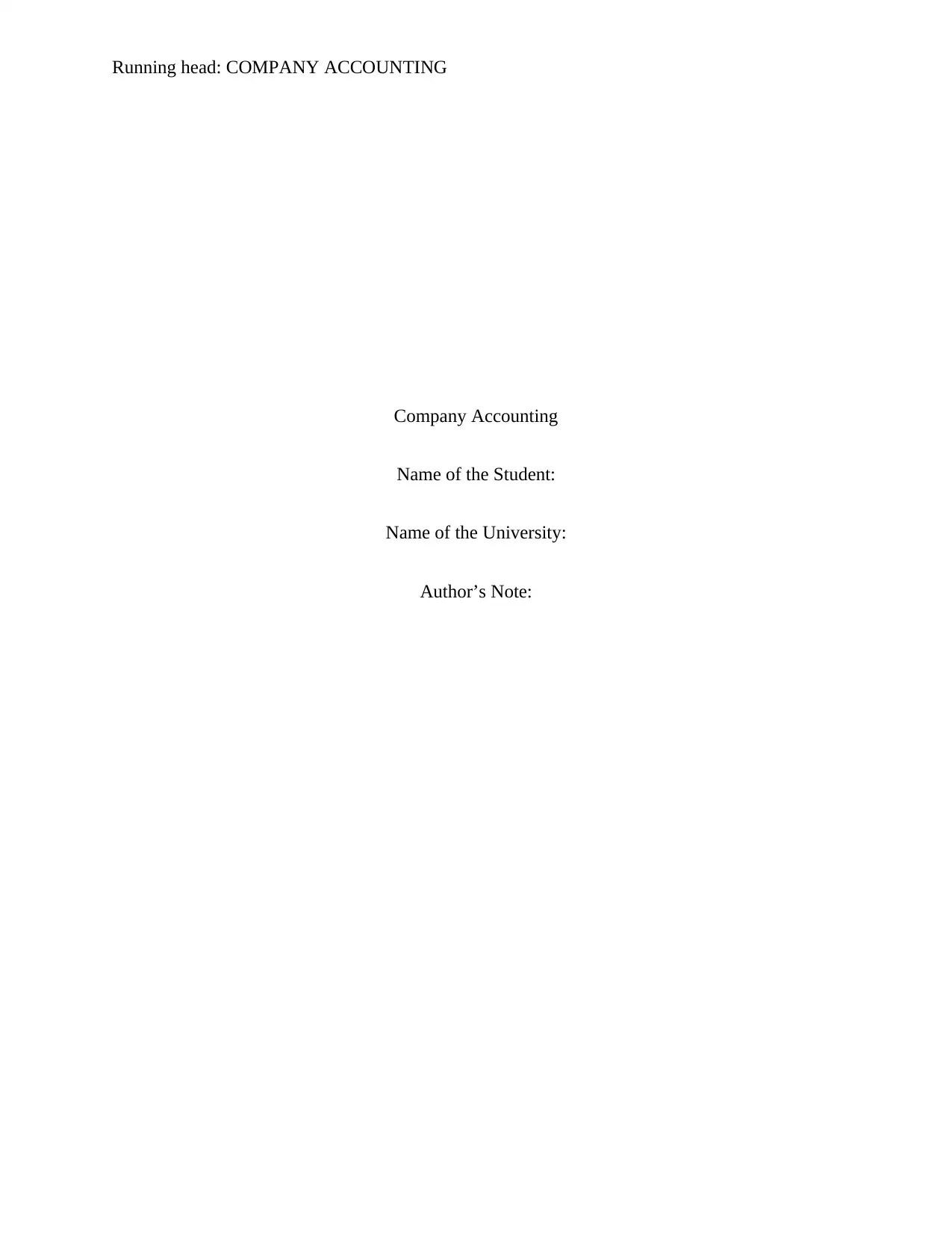
Running head: COMPANY ACCOUNTING
Company Accounting
Name of the Student:
Name of the University:
Author’s Note:
Company Accounting
Name of the Student:
Name of the University:
Author’s Note:
Paraphrase This Document
Need a fresh take? Get an instant paraphrase of this document with our AI Paraphraser
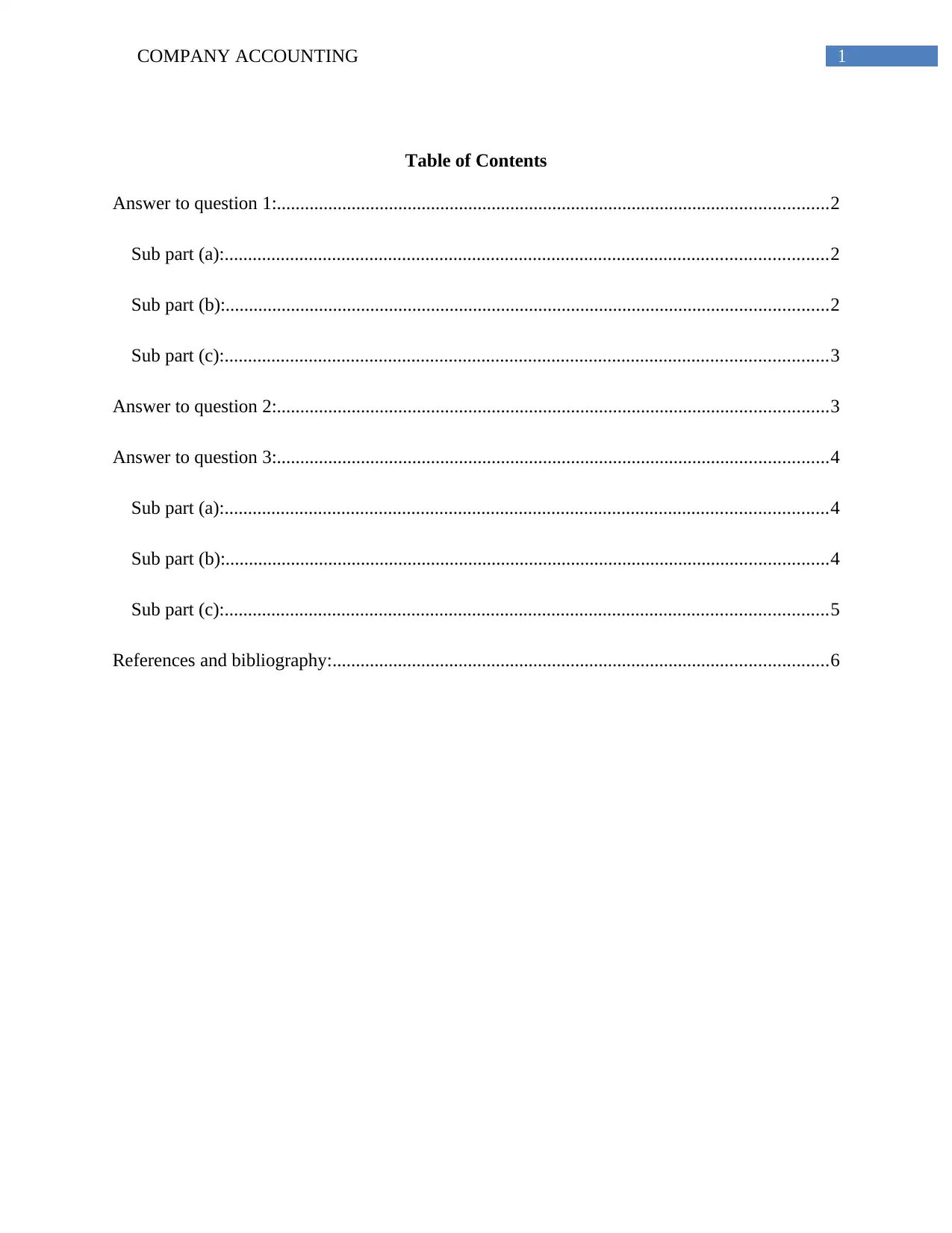
1COMPANY ACCOUNTING
Table of Contents
Answer to question 1:......................................................................................................................2
Sub part (a):.................................................................................................................................2
Sub part (b):.................................................................................................................................2
Sub part (c):.................................................................................................................................3
Answer to question 2:......................................................................................................................3
Answer to question 3:......................................................................................................................4
Sub part (a):.................................................................................................................................4
Sub part (b):.................................................................................................................................4
Sub part (c):.................................................................................................................................5
References and bibliography:..........................................................................................................6
Table of Contents
Answer to question 1:......................................................................................................................2
Sub part (a):.................................................................................................................................2
Sub part (b):.................................................................................................................................2
Sub part (c):.................................................................................................................................3
Answer to question 2:......................................................................................................................3
Answer to question 3:......................................................................................................................4
Sub part (a):.................................................................................................................................4
Sub part (b):.................................................................................................................................4
Sub part (c):.................................................................................................................................5
References and bibliography:..........................................................................................................6
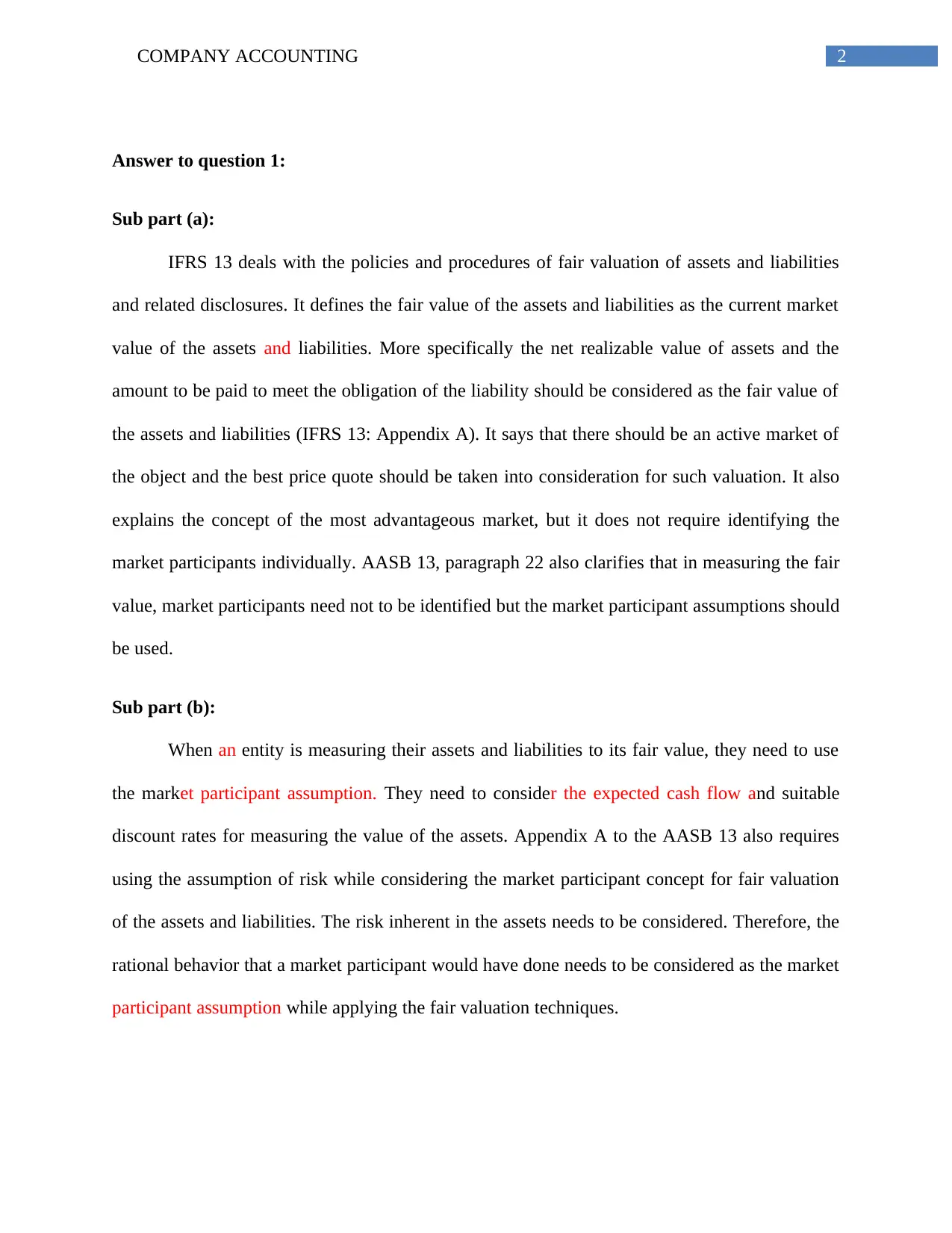
2COMPANY ACCOUNTING
Answer to question 1:
Sub part (a):
IFRS 13 deals with the policies and procedures of fair valuation of assets and liabilities
and related disclosures. It defines the fair value of the assets and liabilities as the current market
value of the assets and liabilities. More specifically the net realizable value of assets and the
amount to be paid to meet the obligation of the liability should be considered as the fair value of
the assets and liabilities (IFRS 13: Appendix A). It says that there should be an active market of
the object and the best price quote should be taken into consideration for such valuation. It also
explains the concept of the most advantageous market, but it does not require identifying the
market participants individually. AASB 13, paragraph 22 also clarifies that in measuring the fair
value, market participants need not to be identified but the market participant assumptions should
be used.
Sub part (b):
When an entity is measuring their assets and liabilities to its fair value, they need to use
the market participant assumption. They need to consider the expected cash flow and suitable
discount rates for measuring the value of the assets. Appendix A to the AASB 13 also requires
using the assumption of risk while considering the market participant concept for fair valuation
of the assets and liabilities. The risk inherent in the assets needs to be considered. Therefore, the
rational behavior that a market participant would have done needs to be considered as the market
participant assumption while applying the fair valuation techniques.
Answer to question 1:
Sub part (a):
IFRS 13 deals with the policies and procedures of fair valuation of assets and liabilities
and related disclosures. It defines the fair value of the assets and liabilities as the current market
value of the assets and liabilities. More specifically the net realizable value of assets and the
amount to be paid to meet the obligation of the liability should be considered as the fair value of
the assets and liabilities (IFRS 13: Appendix A). It says that there should be an active market of
the object and the best price quote should be taken into consideration for such valuation. It also
explains the concept of the most advantageous market, but it does not require identifying the
market participants individually. AASB 13, paragraph 22 also clarifies that in measuring the fair
value, market participants need not to be identified but the market participant assumptions should
be used.
Sub part (b):
When an entity is measuring their assets and liabilities to its fair value, they need to use
the market participant assumption. They need to consider the expected cash flow and suitable
discount rates for measuring the value of the assets. Appendix A to the AASB 13 also requires
using the assumption of risk while considering the market participant concept for fair valuation
of the assets and liabilities. The risk inherent in the assets needs to be considered. Therefore, the
rational behavior that a market participant would have done needs to be considered as the market
participant assumption while applying the fair valuation techniques.
⊘ This is a preview!⊘
Do you want full access?
Subscribe today to unlock all pages.

Trusted by 1+ million students worldwide
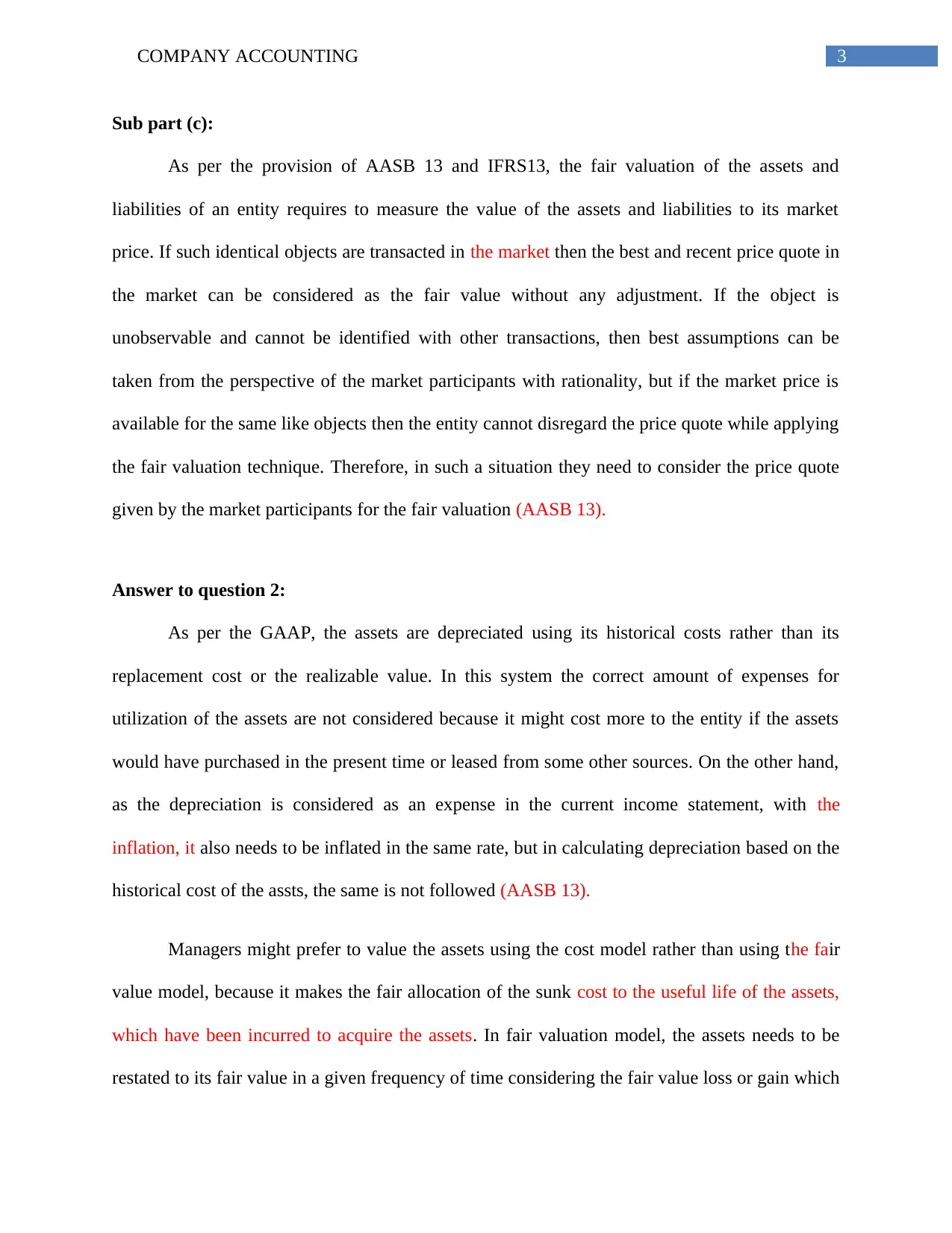
3COMPANY ACCOUNTING
Sub part (c):
As per the provision of AASB 13 and IFRS13, the fair valuation of the assets and
liabilities of an entity requires to measure the value of the assets and liabilities to its market
price. If such identical objects are transacted in the market then the best and recent price quote in
the market can be considered as the fair value without any adjustment. If the object is
unobservable and cannot be identified with other transactions, then best assumptions can be
taken from the perspective of the market participants with rationality, but if the market price is
available for the same like objects then the entity cannot disregard the price quote while applying
the fair valuation technique. Therefore, in such a situation they need to consider the price quote
given by the market participants for the fair valuation (AASB 13).
Answer to question 2:
As per the GAAP, the assets are depreciated using its historical costs rather than its
replacement cost or the realizable value. In this system the correct amount of expenses for
utilization of the assets are not considered because it might cost more to the entity if the assets
would have purchased in the present time or leased from some other sources. On the other hand,
as the depreciation is considered as an expense in the current income statement, with the
inflation, it also needs to be inflated in the same rate, but in calculating depreciation based on the
historical cost of the assts, the same is not followed (AASB 13).
Managers might prefer to value the assets using the cost model rather than using the fair
value model, because it makes the fair allocation of the sunk cost to the useful life of the assets,
which have been incurred to acquire the assets. In fair valuation model, the assets needs to be
restated to its fair value in a given frequency of time considering the fair value loss or gain which
Sub part (c):
As per the provision of AASB 13 and IFRS13, the fair valuation of the assets and
liabilities of an entity requires to measure the value of the assets and liabilities to its market
price. If such identical objects are transacted in the market then the best and recent price quote in
the market can be considered as the fair value without any adjustment. If the object is
unobservable and cannot be identified with other transactions, then best assumptions can be
taken from the perspective of the market participants with rationality, but if the market price is
available for the same like objects then the entity cannot disregard the price quote while applying
the fair valuation technique. Therefore, in such a situation they need to consider the price quote
given by the market participants for the fair valuation (AASB 13).
Answer to question 2:
As per the GAAP, the assets are depreciated using its historical costs rather than its
replacement cost or the realizable value. In this system the correct amount of expenses for
utilization of the assets are not considered because it might cost more to the entity if the assets
would have purchased in the present time or leased from some other sources. On the other hand,
as the depreciation is considered as an expense in the current income statement, with the
inflation, it also needs to be inflated in the same rate, but in calculating depreciation based on the
historical cost of the assts, the same is not followed (AASB 13).
Managers might prefer to value the assets using the cost model rather than using the fair
value model, because it makes the fair allocation of the sunk cost to the useful life of the assets,
which have been incurred to acquire the assets. In fair valuation model, the assets needs to be
restated to its fair value in a given frequency of time considering the fair value loss or gain which
Paraphrase This Document
Need a fresh take? Get an instant paraphrase of this document with our AI Paraphraser
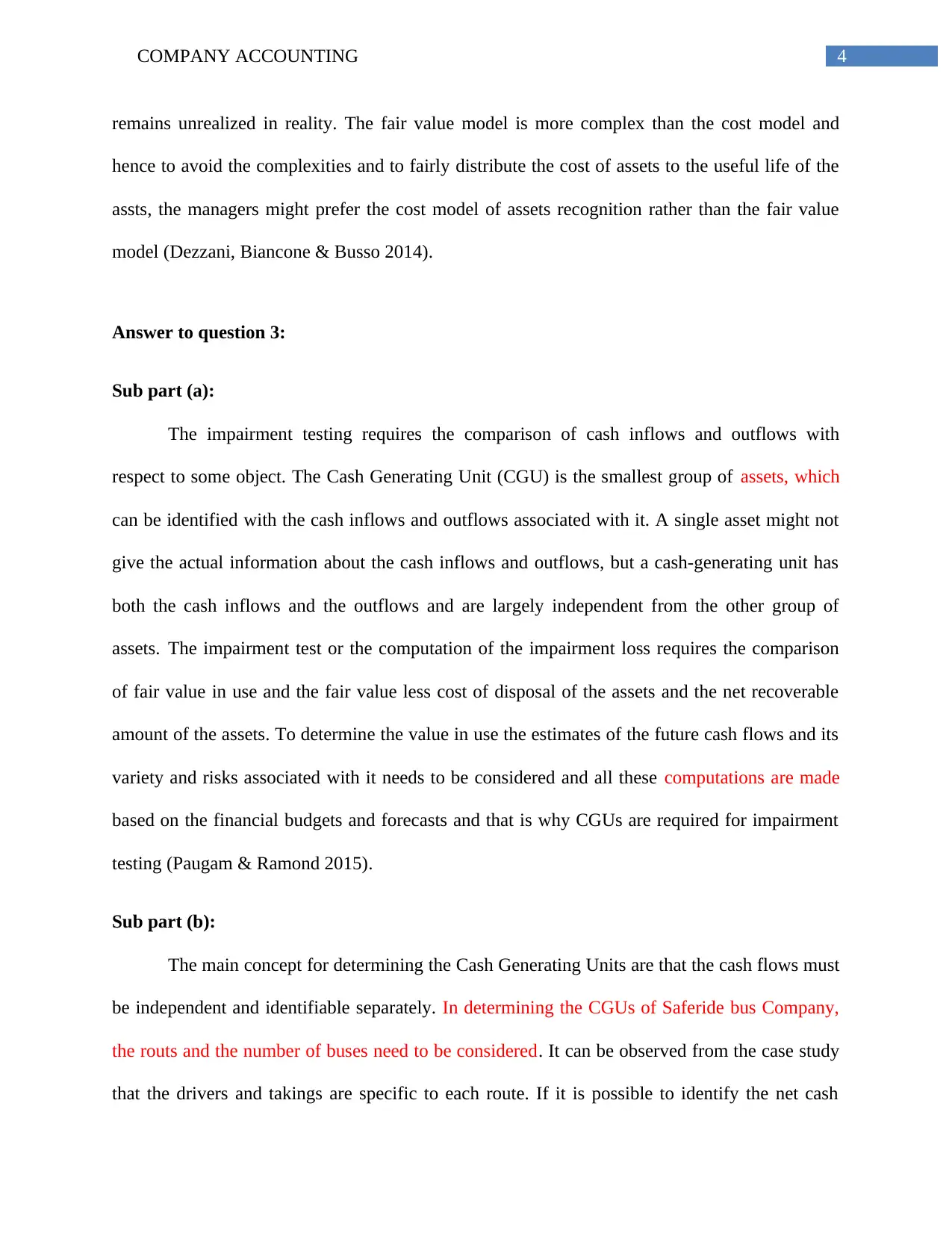
4COMPANY ACCOUNTING
remains unrealized in reality. The fair value model is more complex than the cost model and
hence to avoid the complexities and to fairly distribute the cost of assets to the useful life of the
assts, the managers might prefer the cost model of assets recognition rather than the fair value
model (Dezzani, Biancone & Busso 2014).
Answer to question 3:
Sub part (a):
The impairment testing requires the comparison of cash inflows and outflows with
respect to some object. The Cash Generating Unit (CGU) is the smallest group of assets, which
can be identified with the cash inflows and outflows associated with it. A single asset might not
give the actual information about the cash inflows and outflows, but a cash-generating unit has
both the cash inflows and the outflows and are largely independent from the other group of
assets. The impairment test or the computation of the impairment loss requires the comparison
of fair value in use and the fair value less cost of disposal of the assets and the net recoverable
amount of the assets. To determine the value in use the estimates of the future cash flows and its
variety and risks associated with it needs to be considered and all these computations are made
based on the financial budgets and forecasts and that is why CGUs are required for impairment
testing (Paugam & Ramond 2015).
Sub part (b):
The main concept for determining the Cash Generating Units are that the cash flows must
be independent and identifiable separately. In determining the CGUs of Saferide bus Company,
the routs and the number of buses need to be considered. It can be observed from the case study
that the drivers and takings are specific to each route. If it is possible to identify the net cash
remains unrealized in reality. The fair value model is more complex than the cost model and
hence to avoid the complexities and to fairly distribute the cost of assets to the useful life of the
assts, the managers might prefer the cost model of assets recognition rather than the fair value
model (Dezzani, Biancone & Busso 2014).
Answer to question 3:
Sub part (a):
The impairment testing requires the comparison of cash inflows and outflows with
respect to some object. The Cash Generating Unit (CGU) is the smallest group of assets, which
can be identified with the cash inflows and outflows associated with it. A single asset might not
give the actual information about the cash inflows and outflows, but a cash-generating unit has
both the cash inflows and the outflows and are largely independent from the other group of
assets. The impairment test or the computation of the impairment loss requires the comparison
of fair value in use and the fair value less cost of disposal of the assets and the net recoverable
amount of the assets. To determine the value in use the estimates of the future cash flows and its
variety and risks associated with it needs to be considered and all these computations are made
based on the financial budgets and forecasts and that is why CGUs are required for impairment
testing (Paugam & Ramond 2015).
Sub part (b):
The main concept for determining the Cash Generating Units are that the cash flows must
be independent and identifiable separately. In determining the CGUs of Saferide bus Company,
the routs and the number of buses need to be considered. It can be observed from the case study
that the drivers and takings are specific to each route. If it is possible to identify the net cash
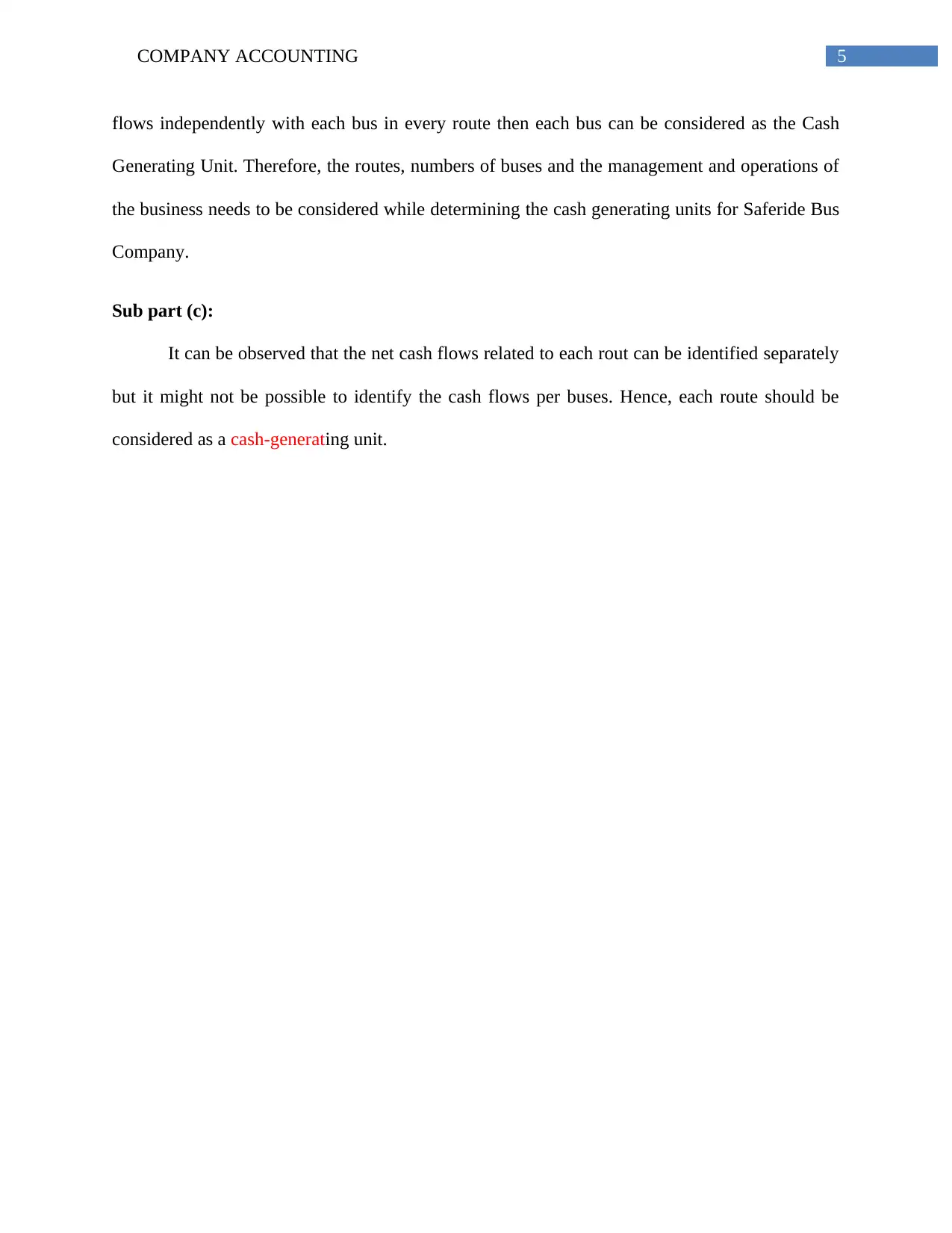
5COMPANY ACCOUNTING
flows independently with each bus in every route then each bus can be considered as the Cash
Generating Unit. Therefore, the routes, numbers of buses and the management and operations of
the business needs to be considered while determining the cash generating units for Saferide Bus
Company.
Sub part (c):
It can be observed that the net cash flows related to each rout can be identified separately
but it might not be possible to identify the cash flows per buses. Hence, each route should be
considered as a cash-generating unit.
flows independently with each bus in every route then each bus can be considered as the Cash
Generating Unit. Therefore, the routes, numbers of buses and the management and operations of
the business needs to be considered while determining the cash generating units for Saferide Bus
Company.
Sub part (c):
It can be observed that the net cash flows related to each rout can be identified separately
but it might not be possible to identify the cash flows per buses. Hence, each route should be
considered as a cash-generating unit.
⊘ This is a preview!⊘
Do you want full access?
Subscribe today to unlock all pages.

Trusted by 1+ million students worldwide
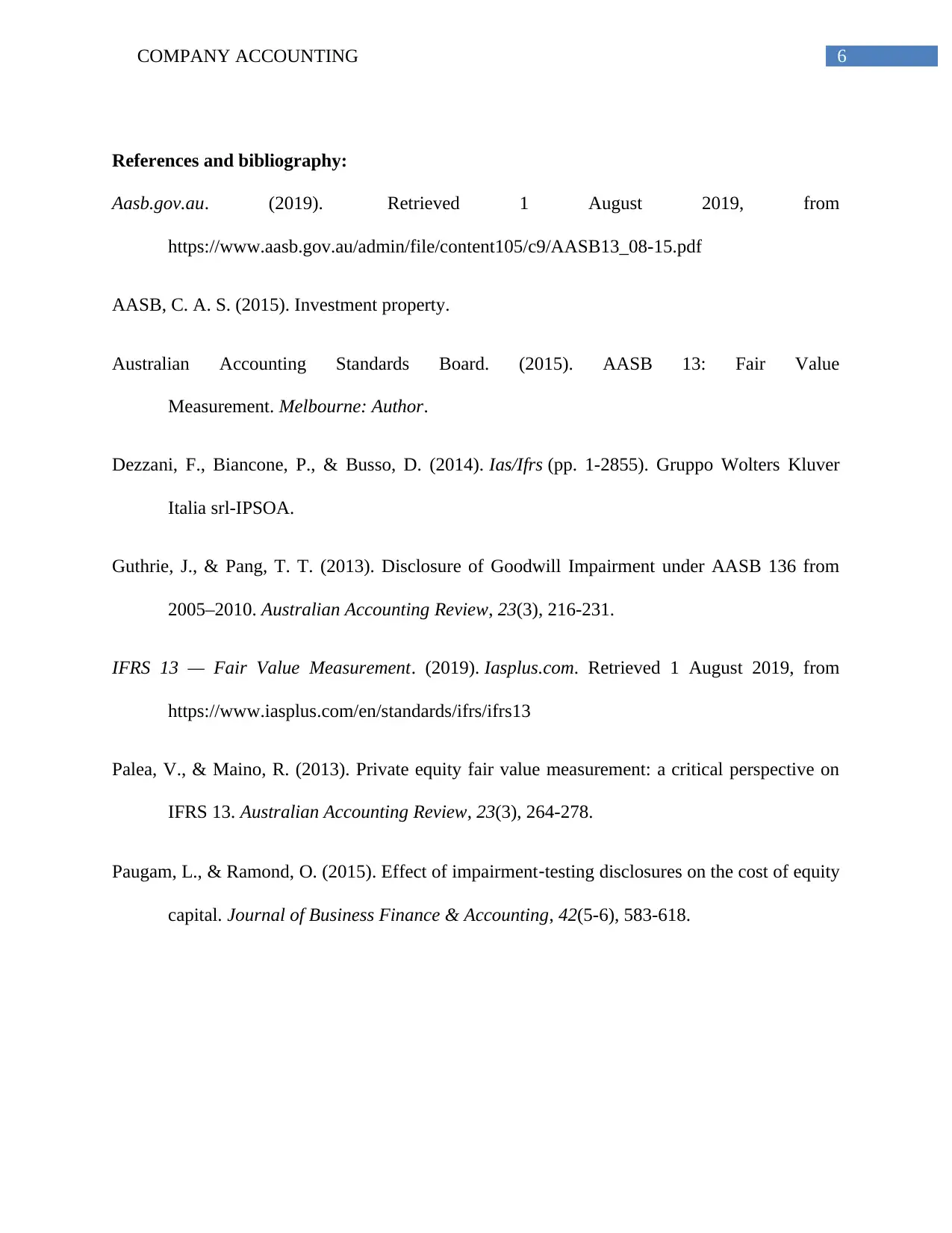
6COMPANY ACCOUNTING
References and bibliography:
Aasb.gov.au. (2019). Retrieved 1 August 2019, from
https://www.aasb.gov.au/admin/file/content105/c9/AASB13_08-15.pdf
AASB, C. A. S. (2015). Investment property.
Australian Accounting Standards Board. (2015). AASB 13: Fair Value
Measurement. Melbourne: Author.
Dezzani, F., Biancone, P., & Busso, D. (2014). Ias/Ifrs (pp. 1-2855). Gruppo Wolters Kluver
Italia srl-IPSOA.
Guthrie, J., & Pang, T. T. (2013). Disclosure of Goodwill Impairment under AASB 136 from
2005–2010. Australian Accounting Review, 23(3), 216-231.
IFRS 13 — Fair Value Measurement. (2019). Iasplus.com. Retrieved 1 August 2019, from
https://www.iasplus.com/en/standards/ifrs/ifrs13
Palea, V., & Maino, R. (2013). Private equity fair value measurement: a critical perspective on
IFRS 13. Australian Accounting Review, 23(3), 264-278.
Paugam, L., & Ramond, O. (2015). Effect of impairment‐testing disclosures on the cost of equity
capital. Journal of Business Finance & Accounting, 42(5-6), 583-618.
References and bibliography:
Aasb.gov.au. (2019). Retrieved 1 August 2019, from
https://www.aasb.gov.au/admin/file/content105/c9/AASB13_08-15.pdf
AASB, C. A. S. (2015). Investment property.
Australian Accounting Standards Board. (2015). AASB 13: Fair Value
Measurement. Melbourne: Author.
Dezzani, F., Biancone, P., & Busso, D. (2014). Ias/Ifrs (pp. 1-2855). Gruppo Wolters Kluver
Italia srl-IPSOA.
Guthrie, J., & Pang, T. T. (2013). Disclosure of Goodwill Impairment under AASB 136 from
2005–2010. Australian Accounting Review, 23(3), 216-231.
IFRS 13 — Fair Value Measurement. (2019). Iasplus.com. Retrieved 1 August 2019, from
https://www.iasplus.com/en/standards/ifrs/ifrs13
Palea, V., & Maino, R. (2013). Private equity fair value measurement: a critical perspective on
IFRS 13. Australian Accounting Review, 23(3), 264-278.
Paugam, L., & Ramond, O. (2015). Effect of impairment‐testing disclosures on the cost of equity
capital. Journal of Business Finance & Accounting, 42(5-6), 583-618.
1 out of 7
Related Documents
Your All-in-One AI-Powered Toolkit for Academic Success.
+13062052269
info@desklib.com
Available 24*7 on WhatsApp / Email
![[object Object]](/_next/static/media/star-bottom.7253800d.svg)
Unlock your academic potential
Copyright © 2020–2025 A2Z Services. All Rights Reserved. Developed and managed by ZUCOL.





